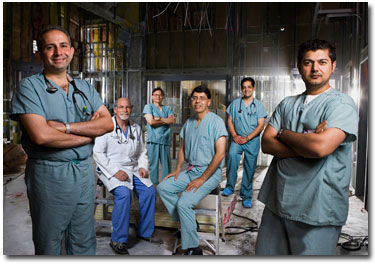Interventional Cardiology / Vascular Surgery
Treating Patients From Tulare County
Every year, more than 5,500 cardiovascular procedures are performed inside Kaweah Health’s Cardiovascular Center. There are four cardiovascular labs each equipped with state-of-the-art imaging and monitoring technology. These procedures are used to treat coronary artery disease, peripheral artery disease, and myocardial infarction, better known as heart attack.
Common procedures include:
- Cardiac /Vascular Angiography
- Coronary Intervention (Angioplasty / Stenting/ IVUS)
- Peripheral Intervention (Angioplasty / Stenting/ Athrectomy)
- Carotid Stenting
- Thrombectomy
- Thrombolysis
- Patent Foramen Ovale (PFO) Closure
Cardiac catheterization
Cardiac catheterization is a procedure accomplished by passing small tubes or catheters into the heart from arteries and veins in the groin or arm. A cardiologist with specialized training performs it. The study includes the observation of the heart's pumping function and the visualization of the coronary arteries, which supply the heart muscle with blood.
Echocardiogram (echo) and doppler ultrasound
These are tests where ultrasound waves are sent through the body and returned through a microphone. An echo study provides an image of the moving heart and allows examination of the movement of blood through the heart.
Stress echocardiogram (stress echo)
This is an echocardiography examination conducted during exercise. Exercise will be done using a treadmill or if walking is difficult, medication can be infused to simulate exercise. An echocardiogram is performed immediately after exercising. An echo study provides an image of the moving heart and allows examination of the movement of blood through the heart.
Stress Test (Treadmill)
This is an electrocardiogram (ECG) study conducted during exercise. Exercise will be done using a treadmill or if walking is difficult, medication can be infused to simulate exercise. During exercise, the ECG measures and records the heart's electrical impulses as they travel through the heart muscle. It indicates if there is damaged heart tissue interfering with the normal flow of electrical impulses through the heart.
Thallium Stress Test
This is a type of nuclear scanning test for myocardial perfusion (blood flow in the heart). This test shows how well blood flows to the heart muscle. It is done in conjunction with an exercise stress test on a treadmill.
Electrocardiogram (ECG)
This is a test in which several electronic sensors are placed on the body to monitor electrical activity associated with the heartbeat.
Chest X-Ray
This is one of the simplest diagnostic tools. It will tell the size, shape of the heart, and the condition of the lungs.
Holter Electrocardiogram (ECG)
This is a continuous recording of the heart's rhythm for 24 or 48 hours. The Holter ECG will provide the physician with a record of how your heart reacts to situations during rest, activity, and stress while in the home environment.
Permanent Pacemaker
This is an electronic device consisting of an electrode connected to the heart muscle and a regulatory device and power source implanted in the skin. It provides regular, mild electric shocks that stimulate the heart muscle and maintain normal heartbeat.
Balloon angioplasty
This is a procedure performed by cardiologists to help open narrowing in the coronary arteries. This procedure requires passing a catheter with a small balloon at its tip into the artery. The balloon is then inflated in the artery to eliminate the narrow area.
Atherectomy (Rotorooter)
This is a procedure for opening coronary arteries blocked by plaque. Atherectomy uses a rotating shaver, ("burr" device on the end of a catheter). The catheter is inserted into the body the same way as in angioplasty. The burr then shaves the plaque, opening the artery.
Stent
A stent is a wire mesh tube used to open an artery with plaque build-up and increase blood flow. The stent is collapsed placed over a balloon catheter inserted through the groin or arm vein and is placed in the area of the blockage; inflating the balloon then deploys the stent. The stent forms to the artery like scaffolding, keeping it from closing. Some stents have plaque-reducing drugs in them to further help dissolve the plaque build-up.
Meet the Doctors

Interventional Cardiologists:
- Kusai Aziz, M.D.
- Frank Gavini, M.D.
- Vinod Gupta, M.D.
- H. Rajender Reddy, M.D.
- Shashi Sharma, M.D.
- Nallathamby Thayapran, M.D.
- Aditya Verma, M.D.
- Ashok Verma, M.D.
Diagnostic Cardiologists:
- David Cislowski, M.D.
- Dennis Johnson, M.D.
- John Lin, M.D.
- Harry Lively, M.D.
- Barry Meyer, M.D.
